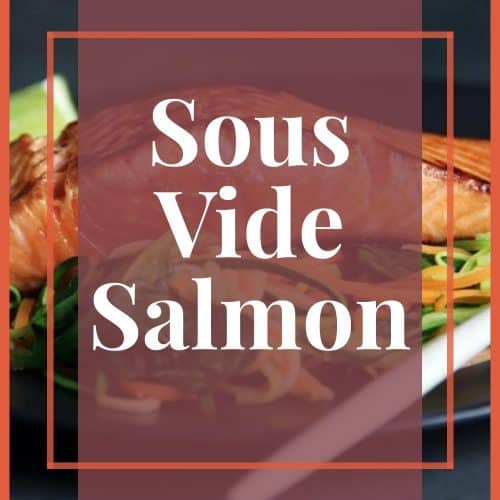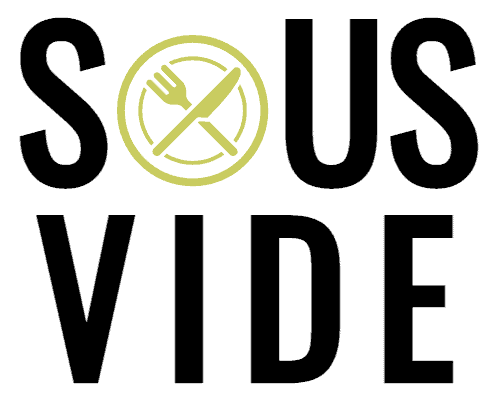Most of the time we’ll smoke or grill salmon. But there’s a better way to bring out the flavors and get that perfect center, and it’s sous vide.
This Sous Vide Salmon Recipe is one of my favorites.

Table of Contents
Sous Vide Salmon Recipe
Equipment
- Sous Vide Cooker
- Sous Vide Container
- Vacuum Sealer
- Vacuum Seal Bags
Ingredients
For the Salmon
- 14 Ounces (400 grams) Salmon Fillet
- 1 Ounce (30 grams) Cane Sugar
- 0.7 Ounces (20 grams) Salt
- Orange and Lemon Peel
- 1 Ounce (30 grams) Vodka
For the Sauce
- 10 Small Tomatoes
- 0.5 Onion (half)
- 2 tbsp Olive Oil
- 1 tbsp Capers
Instructions
- Set the sous vide cooker at 60°C /140°F and begin to prepare the salmon fillets.
- Insert the salmon in a vacuum seal bag. Add the sugar, salt, vodka and lastly the orange peel.The vodka is optional, but it’s the most effective way to extract the flavor of the orange and lemon peels. It'll help the salmon to get those flavors faster.
- Seal the vacuum bag and put it in the water bath. Let the salmon cook for 35 minutes. In the meantime, let’s prepare a tomato sauce to complement the salmon.
- Cut the small tomatoes into 4 wedges, and heat 2 tbsp of olive oil in a small pan.
- Add the capers to the pan and let them simmer for 30 seconds.
- Add the chopped onion, let it cook for 3 minutes at low heat, then add the tomatoes.
- Season with salt and pepper. Your sauce is ready now.
- When the salmon is done, take it out and dry it.
- Roast the salmon in a hot pan with a teaspoon of olive oil. This will give us a roasted and crunchy salmon skin, and it will add more flavor to the salmon.
Notes
Why Sous Vide Salmon
Cooking salmon using sous vide requires no guessing and lets you add fat and flavor to the salmon easily.
This recipe works for any kind of fish, but you should only use whole fish because they will cook better and hold their shape better than fillets.
In my experience, salmon fillets are easily undercooked and overcooked when pan-seared or poached because of the high temperatures from the pan or boiling water. Salmon isn’t the cheapest food, so you don’t want to waste the salmon fillets.
Sous vide is one of the best techniques for cooking food perfectly each time. It allows you to achieve flaky and moist texture that you have only dreamed about and gives your food an unbeatable flavor.
The downside of cooking salmon (and other flaky fish) sous vide is that it becomes more delicate after cooking it. That means it can potentially flake and break apart before you even get it on the plate. But you’ll know that it’s perfectly cooked even throughout.
What Temperature and Timing Should I Use?
Salmon is highly susceptible to temperature variations in the protein structure. The soft-setting proteins are easily damaged, so try to cook your salmon at a consistent temperature.
The general range for sous vide cooking salmon is between 120°F (49°C) to 140°F (60°C). This recipe is my personal favorite and I like it best when I cook it to 140°F (60°C) for 35 minutes, which results in a fish that is cooked evenly, while still holding its structure.
Be careful if the salmon is in low-temperature water too long as it can become mushy. If left in high-temperature water too long, the salmon will be dry and become flaky.
The time to cook salmon fillets can be different depending on the thickness. If your salmon fillet is extra-thick, you’ll need to it for 45-60 minutes. For thinner fillets, 30-40 minutes is more than enough.
When salmon is sous vide cooked above the pasteurization point of 130°F (54°C), be sure to serve it within 3 hours from when you start cooking. Otherwise, bacteria can grow and cause spoilage. If you don’t plant to eat it immediately after cooking, it’s best to chill it in an ice bath afterwards.
What Type of Salmon Should I Buy?
Most salmon is best when caught fresh, but if you have time, you can also choose to store frozen salmon for up to six months. If you’re going to buy salmon in the freezer, get the freshest one possible.
Buy salmon from a supermarket, but pay attention to the appearance. It should be shiny and have no marks or stains on it. If you catch your own fish or buy it from the market, it should be firm when you hold it.
Skin On or Skin Off?
I love crispy sous vide salmon skin, so I prefer to have the skin on. You can get the crispy salmon skin with a quick sear.
But if you prefer it skinless, you can get rid of the skin more easily after it’s finished cooking. Cooking will loosen the link between the meat and skin. Cooking with the skin on will also help hold the salmon fillet together. It will break apart much more easily without the skin.
Searing Salmon After Sous Vide Cooking
To get that crispy skin, do a quick pan sear of the cooked salmon fillet with the skin side down. Searing for 45-60 seconds on high heat will be good.
This can also help give the salmon some great flavor from the skin.
It’s best to eat it soon after the meal, or at least as soon as 30 minutes after the meal. The salmon will start drying out as it sits out.
Check out these other tasty recipes:

Salmon is so good cooked sous vide!